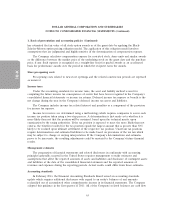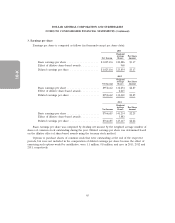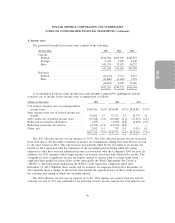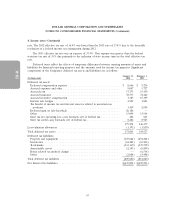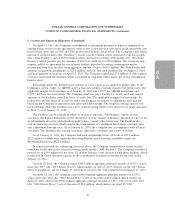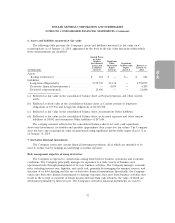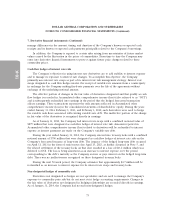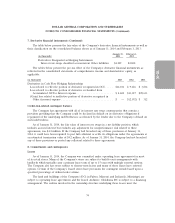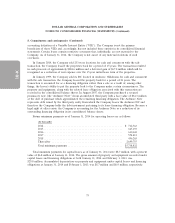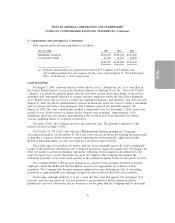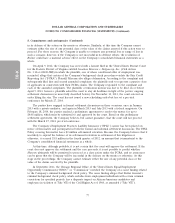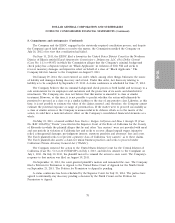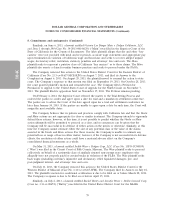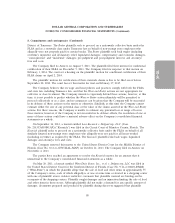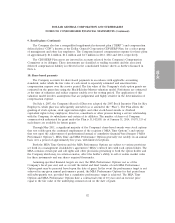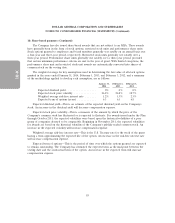Dollar General 2013 Annual Report Download - page 150
Download and view the complete annual report
Please find page 150 of the 2013 Dollar General annual report below. You can navigate through the pages in the report by either clicking on the pages listed below, or by using the keyword search tool below to find specific information within the annual report.
DOLLAR GENERAL CORPORATION AND SUBSIDIARIES
NOTES TO CONSOLIDATED FINANCIAL STATEMENTS (Continued)
7. Derivative financial instruments (Continued)
manage differences in the amount, timing, and duration of the Company’s known or expected cash
receipts and its known or expected cash payments principally related to the Company’s borrowings.
In addition, the Company is exposed to certain risks arising from uncertainties of future market
values caused by the fluctuation in the prices of commodities. From time to time the Company may
enter into derivative financial instruments to protect against future price changes related to these
commodity prices.
Cash flow hedges of interest rate risk
The Company’s objectives in using interest rate derivatives are to add stability to interest expense
and to manage its exposure to interest rate changes. To accomplish this objective, the Company
primarily uses interest rate swaps as part of its interest rate risk management strategy. Interest rate
swaps designated as cash flow hedges involve the receipt of variable-rate amounts from a counterparty
in exchange for the Company making fixed-rate payments over the life of the agreements without
exchange of the underlying notional amount.
The effective portion of changes in the fair value of derivatives designated and that qualify as cash
flow hedges is recorded in Accumulated other comprehensive income (loss) (also referred to as ‘‘OCI’’)
and is subsequently reclassified into earnings in the period that the hedged forecasted transaction
affects earnings. These transactions represent the only amounts reflected in Accumulated other
comprehensive income (loss) in the consolidated statements of shareholders’ equity. During the years
ended January 31, 2014, February 1, 2013, and February 3, 2012, such derivatives were used to hedge
the variable cash flows associated with existing variable-rate debt. The ineffective portion of the change
in fair value of the derivatives is recognized directly in earnings.
As of January 31, 2014, the Company had interest rate swaps with a combined notional value of
$875 million that were designated as cash flow hedges of interest rate risk. Amounts reported in
Accumulated other comprehensive income (loss) related to derivatives will be reclassified to interest
expense as interest payments are made on the Company’s variable-rate debt.
During the year ended January 31, 2014, the Company entered into treasury locks with a combined
notional amount of $700 million that were designated as cash flow hedges of interest rate risk on the
Company’s forecasted issuance of long-term debt. The issuance of the hedged long-term debt occurred
on April 11, 2013 in the form of senior notes due April 15, 2023, as further discussed in Note 5, and
the related settlement of the treasury locks on that date resulted in a loss of $13.2 million which was
deferred to OCI. The loss is being amortized as an increase to interest expense over the period
corresponding to the debt’s maturity as the Company accrues or pays interest on the hedged long-term
debt. There was no ineffectiveness recognized on these designated treasury locks.
During the next 52-week period, the Company estimates that approximately $4.7 million will be
reclassified as an increase to interest expense for its interest rate swaps and treasury locks.
Non-designated hedges of commodity risk
Derivatives not designated as hedges are not speculative and are used to manage the Company’s
exposure to commodity price risk but do not meet strict hedge accounting requirements. Changes in
the fair value of derivatives not designated in hedging relationships are recorded directly in earnings.
As of January 31, 2014, the Company had no such non-designated hedges.
73
10-K


